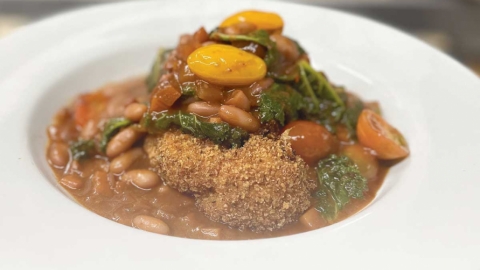Eating Wild: Northern Bayberry, the Local Alternative to a Culinary Staple
Soup, I firmly believe, is one of the world’s perfect foods. In the summer few things are as delicious as a cold bowl of gazpacho, which my grandmother used to freeze in huge batches and defrost for me and my sister every time we would visit. In the fall, when all manner of root vegetables and thick-skinned squash are being harvested in abundance, I look forward to ending a day outdoors with a creamy bowl of jewel-toned, richly-seasoned bisque. Throughout the winter, I delight in slow-simmering bones, herbs, and vegetable ends on the stove for hours, the steam fogging up the windows and filling the house with the scents of comfort and coziness. And in the spring, when the first fresh greens, herbs, and asparagus shoots arrive at our local farm stands, I love preparing batches of the greenest soups imaginable – the perfect way to celebrate the arrival of the growing season.
There are truly so, so many soups to be enjoyed during every time of year, to suit every mood or palate, and to fit every amount of time you hope to spend in the kitchen. And in a great many of those recipes, a specific item tends to appear, far down the list of ingredients, in such a small quantity that you wonder if it even matters if you include it: bay leaves.
“Add two bay leaves,” your chicken soup recipe will instruct toward the beginning of the preparation steps, only to later tell you to “remove and discard the bay leaves before serving.”
The bay leaves most frequently referred to in those recipes belong to an evergreen tree that grows in warm climates and belongs to the Lauraceae family of plants. Whether or not it does, in fact, matter if you add it to your recipes has a lot to do with how old the bay leaves sitting in the back of your spice cabinet happen to be. If you break a leaf in half and it doesn’t smell like anything, then your leaves are likely too old, and you are most certainly wasting your time by adding them to your braises and stocks. A good bay leaf, on the other hand, will release a rich, potent, tea/menthol fragrance that, much like other herbs and spices that are used in small quantities, should bring a more complex layer of flavor to your dishes.
I am lucky enough to have a friend whose father grows bay trees at his Florida home, and that friend brings back bags of bay leaves to share when she returns from visits south. But in the event that I run out of those bay leaves, or (as is the case at the time of writing this article) those gifted leaves have also aged past their point of potency, I turn to an unrelated, but similarly named, northeastern plant for my culinary needs – the wild-growing and abundant northern bayberry.
Northern bayberry (Morella pensylvanica, formerly referred to as Myrica pensylvanica) is a plant in the Myricaceae family that grows around Cape Cod and other sandy, seaside locations along the East Coast. The plant often appears in huge stands, and I have found seemingly endless swaths of northern bayberry thriving in numerous locations from Maine to Maryland. As opposed to the much taller evergreen bay trees that reside in balmy climates, northern bayberry is a mostly deciduous shrub – in warmer years the leaves don’t always fall off the plants – that often appears in hedges that reach from only a foot tall to around six feet tall.
The leaves of the northern bayberry plant are smaller, less leathery, and more delicate than those of the evergreen bay called for in recipes, with a corresponding more delicate scent when broken. These oblong leaves grow alternately up their woody stems, are generally one to three inches long, and have a few very subtle rounded teeth at the very end. If you think you have found northern bayberry, crush a few leaves in your hand and breathe in the fragrance released. If it smells similar to the bay you are familiar with, chances are good you have located a stand of this common plant. Since there are some vaguely similar looking plants to northern bayberry, particularly within the Myricaceae family which also includes sweetfern (which I’ve written about here) and sweet gale, make sure you are doing your due diligence when identifying this plant for use, and checking with multiple sources, looking at multiple parts of the plant, and consulting with experts.
If you have located some northern bayberry, and the plants are still flush with green leaves, you can harvest a smattering of those leaves from various plants, making sure to leave each plant with plenty of healthy leaves. Once harvested, leaves can be used either fresh or dried. To dry, place leaves in a single layer on trays in a food dehydrator set to the lowest setting, or on a baking tray in a very low oven. They are done when each leaf is completely brittle, and can be crumbled and cracked between your fingers. I tend to use twice as many northern bayberry leaves in a recipe as I would traditional bay leaves, since they are smaller and a bit less potent in aroma and flavor. While northern bayberry leaves aren’t as tough as their (unrelated) common counterparts, they are generally still too tough to leave in at the end of cooking, so continue to follow that “remove and discard the bay leaves before serving” instruction if you are using the leaves in a braise or soup.
I add northern bayberry leaves to all sorts of soups and vegetable braises, and find them to be particularly useful in the creamy chowders that I make using another Cape Cod resource: fish and shellfish. You can also use northern bayberry leaves to make your own version of Old Bay seasoning by grinding up dried northern bayberry leaves along with paprika, celery salt, pepper, cinnamon, and other spices of your choosing. The ground spice mix can then be used as a dry rub, or as an added ingredient in meat and seafood dishes.
Though leaves are the only part of the northern bayberry plant that I have harvested, the fragrant grayish blue wax that coats the tiny fruit of this plant has also been used since the 1700s, and gives northern bayberry one of its common names: candleberry. When both male and female plants are growing together in one spot, the female plants bear clusters of small, grayish berries that are covered in a highly aromatic wax. I have never found enough fruiting plants in one place to test using this wax in my homemade candles, if you are lucky enough to stumble upon a bounty of mature berries you can pick a few of the small bunches and slowly simmer them in a pot of water until the wax melts off the berries. Once melted, let the water/wax mixture cool. The melted wax should float and harden on the surface of the water and can be removed for use. (Helpful candle-making tip: Use a pot and utensils for this that you don’t care about, since wax is very difficult to completely clean from surfaces.) Mix the wax in with the other ingredients you use to make your candles – soy, lard, tallow, beeswax, etc. – before setting a wick in place and letting the candle solidify completely. You can then enjoy the soothing fragrance of this plant in your home year round.
While there are many ingredients that hail from tropical climates and need to be sourced from afar, northern bayberry provides us with that delightful find of the foraging world, a local alternative. So the next time you go on a seaside stroll or wooded wander, look out for a stand of these waxy-leaved bushes, break off a few leaves, and take a sniff. Then fill your harvest basket, head home, and whip up a batch of your favorite soup.
*NOTE: Always consult with trusted experts and refer to foraging books and field guides for 100% positive plant identification before consuming any wild plant. As with harvesting any wild plant, and particularly ones that grow in commonly-sprayed areas, take particular care to collect from spaces you know to be chemical-free. Never pick any wild plant from protected spaces. Integrate new foods into your diet in small quantities to gauge any dietary and allergy sensitivities, and consult with a doctor if you have any questions or concerns about specific health issues or medication interactions.
Becca Miller lives in the Adirondack Mountains and works as a professional farm-to-classroom educator, writer, and photographer. A former Cape Codder in residence but always a Cape Codder at heart, Becca spent her time living on the Cape running a CSA program where she taught members how to use harvest items in new and creative ways. Becca is a Certified Master Food Preserver and a Leave No Trace Trainer, and her writing has been featured in Edible Capital District, Edible Vermont, and Adirondac magazines, along with Alice Waters’ Edible Schoolyard blog and Mother Earth Living’s Food Matters blog. Find Becca’s writing at beccamillerwriting.weebly.com








